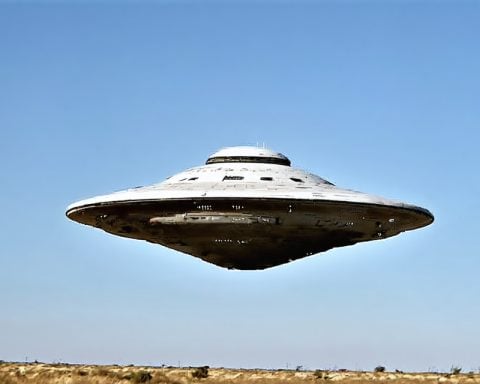Is There Life Beyond Earth?
In a recent statement, Professor Tim Coulson from Oxford University dismissed the long-held belief in the Loch Ness Monster and similar creatures, labeling them as mere fantasies. According to the prominent biologist, the absence of credible evidence—from bones to photographs—proves that such legendary beings could not possibly exist in our world.
For a creature reminiscent of dinosaurs to thrive in Loch Ness, hundreds would need to inhabit the area for millions of years. However, Coulson asserts that the reality is far less likely, leading him to conclude that these myths are simply products of human imagination.
While Coulson has put the Loch Ness Monster, Yeti, and Bigfoot to rest, he remains open-minded about the possibilities of extraterrestrial life. He points out that our exploration of space is still in its infancy, making it premature to dismiss the existence of aliens. He emphasizes that we have only scratched the surface of our universe, leaving room for the potential discovery of life—whether it be microbes or more advanced organisms.
Despite the scientific conclusions, tourism at Loch Ness flourishes, attracting visitors who remain fascinated by the monster legend, generating significant revenue for the region. Perhaps, while the myths may fade, the allure of the unknown continues to captivate the human spirit.
Exploring the Cosmos: Implications Beyond Earth
The ongoing quest to understand life beyond our planet not only stimulates scientific curiosity but also carries profound impacts on society and culture. As humanity expands its gaze into the cosmos, we are confronting the notion of our place within the universe. The search for extraterrestrial life, through missions involving rovers on Mars and advanced telescopes peering into distant galaxies, fosters a spirit of global collaboration among scientists, engineers, and nations.
Moreover, this quest could significantly influence the global economy. For instance, companies are investing billions into space exploration, offering jobs and driving innovation in technology. The burgeoning space tourism industry suggests that our fascination with the unknown could yield economic benefits while igniting public interest in STEM fields.
The environmental implications of increasing space exploration are also noteworthy. As we push the boundaries of our knowledge, we must consider the sustainability of our activities—from potentially contaminating other celestial bodies to the carbon footprint of launching spacecraft. Future missions must prioritize ecological responsibility as we tread into the unknown.
In summary, while debates surrounding myths like the Loch Ness Monster may dissolve, the inquiry into extraterrestrial life provokes critical questions about our existence, encourages global partnerships, and highlights the need for responsible stewardship as we venture into the final frontier.
Are We Alone in the Universe? Exploring the Debate on Extraterrestrial Life
Understanding the Search for Life Beyond Earth
The question of whether life exists beyond our planet has captivated humanity for centuries. With ongoing advancements in technology and exploration, the scientific community continuously seeks answers to this profound mystery. Despite recent dismissals of legendary creatures like the Loch Ness Monster by experts such as Professor Tim Coulson, the intrigue surrounding extraterrestrial life remains vibrant and relevant.
Current Trends in Astrobiology
Astrobiology has emerged as a key field dedicated to understanding potential life in extreme environments on Earth, which may mimic conditions on other planets. Research is focused on locations like Antarctica’s subglacial lakes and the deep ocean floor, where scientists have discovered microbial life thriving under conditions once thought uninhabitable. These findings could provide insights into where and how life might exist elsewhere in the universe.
Innovations Driving Space Exploration
1. Space Telescopes: Instruments like the James Webb Space Telescope are redefining our view of the cosmos, allowing for the discovery of exoplanets in habitable zones around distant stars.
2. Robotic Missions: NASA’s Perseverance rover and the Mars Sample Return mission aim to uncover signs of past life on Mars. Meanwhile, missions to moons such as Europa and Enceladus are exploring subsurface oceans that could harbor life.
3. SETI Initiatives: The Search for Extraterrestrial Intelligence continues to scan the skies for signals, employing advanced algorithms and machine learning to analyze vast datasets.
Pros and Cons of Searching for Extraterrestrial Life
Pros:
– Scientific Advancement: Discovering life beyond Earth could revolutionize our understanding of biology, evolution, and the conditions necessary for life.
– Philosophical Impact: It challenges our beliefs about our place in the universe and enriches our understanding of existence.
Cons:
– Resource Allocation: Funding for space missions could divert attention and resources from pressing global issues.
– Potential Risks: Engaging with extraterrestrial entities brings ethical considerations and the potential risks of contamination.
Use Cases for Astrobiology Research
– Understanding Evolution: By studying how life adapted to extreme environments on Earth, scientists can predict how life might evolve on other planets.
– Chemical Analysis: Research into abiogenesis (the origin of life from non-living matter) helps refine methods to detect biosignatures on other celestial bodies.
Limitations and Challenges
Despite significant advancements, many challenges remain:
– Distance and Accessibility: Many celestial bodies are light-years away, making exploration logistically challenging.
– Technological Limitations: Current technology imposes constraints on what can be detected and analyzed in distant atmospheres.
Predictions for the Future of Astrobiology
Experts predict that within the next few decades, technological advancements will enable more detailed exploration of Mars and the outer solar system. Additionally, the discovery of potential biosignatures on exoplanets may become a reality, further fueling the debate on extraterrestrial life.
Conclusion: The Quest Continues
As we advance in our understanding of both our planet and the universe, the question of extraterrestrial life remains one of humanity’s most compelling pursuits. While legends of creatures like the Loch Ness Monster may be debunked, our fascination with what lies beyond Earth continues to provoke curiosity, ensuring that the search for life—whether microbial or intelligent—remains at the forefront of exploration.
For more insights into our universe, visit NASA for the latest in space exploration and discoveries.


















